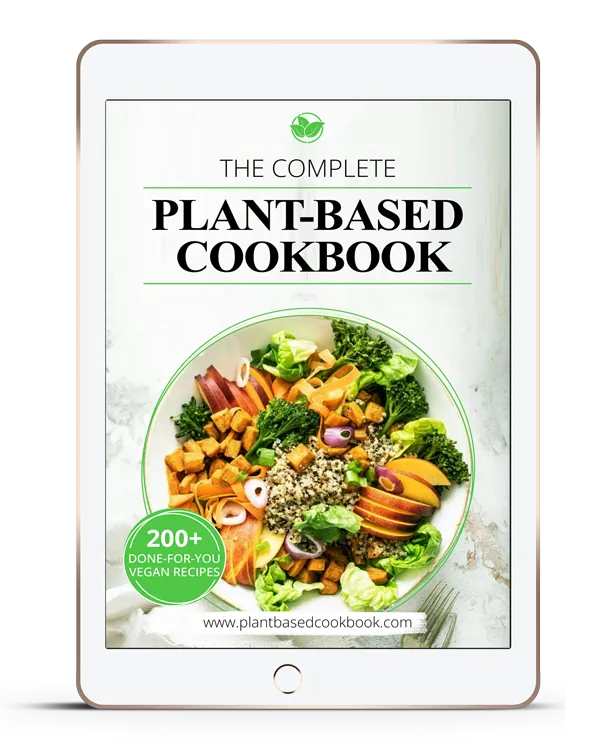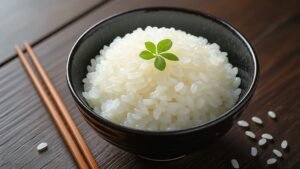Just as we were pondering the versatility of our kitchen appliances, we came across an unexpected culinary revelation: rice cookers aren’t just for rice anymore.
We’ve discovered that these unassuming gadgets are secret weapons for creating mouthwatering soups and, with a range of settings at our fingertips, we’re about to venture on a flavorful journey that’ll transform how we approach soup-making. From slow-simmering broths to nutrient-packed veggie concoctions, the possibilities are endless.
But before we gorge ourselves on the savory details, let’s consider how these ten rice cooker settings can elevate our soup game to restaurant-quality levels.
Table of Contents
TogglePorridge/Soup Setting
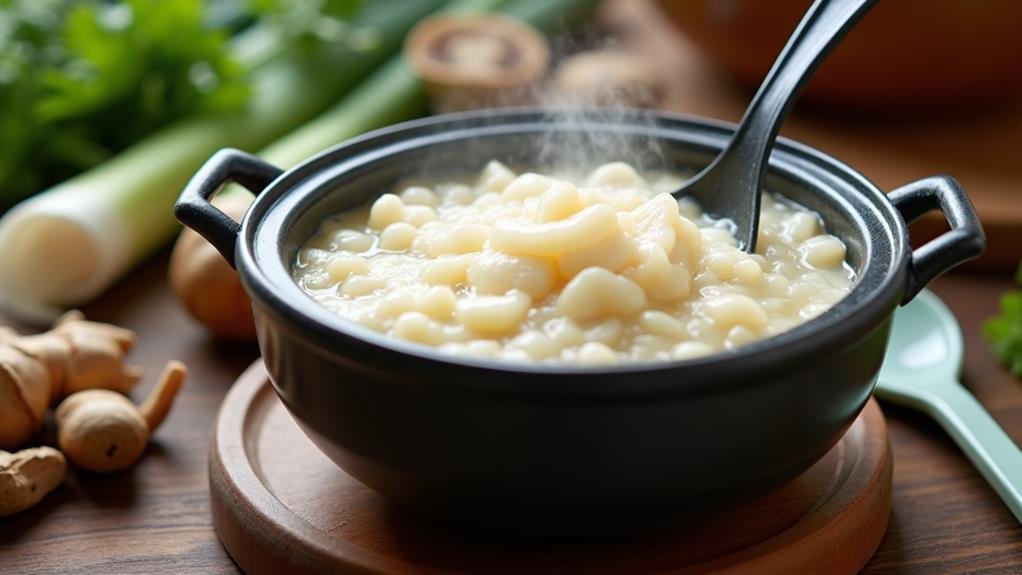
With the Porridge/Soup function on your rice cooker, you’ll unlock a world of delicious, hearty soups and stews. This function is particularly advantageous for cooking various types of porridge, as it allows for a slow simmer that enhances texture and flavor, making it ideal for dishes like various porridge options. We’re thrilled to reveal how this specialized feature can elevate your soup-making skills and bring you closer to culinary excellence.
The Porridge/Soup function is a game-changer for soup enthusiasts like us. It’s crafted to simmer ingredients slowly, allowing flavors to develop and blend together beautifully. The extended cooking time and lower temperature guarantee that every element of your soup is cooked evenly and thoroughly, without the possibility of burning or sticking to the bottom of the pot.
We adore how this function removes the uncertainty from soup-making. It’s akin to having a personal chef who knows precisely how long to cook your ingredients for the best taste and texture. By utilizing the Porridge/Soup function, we’re all members of a community of home cooks who can whip up restaurant-quality soups with minimal effort.
Remember to adhere to your rice cooker’s specific guidelines for the finest outcomes. With this function, we can all relish the comfort and coziness of homemade soups, uniting us around the table for nourishing meals.
Slow Cook Function
Moving beyond the Porridge/Soup setting, we’ve discovered another fantastic feature that’ll revolutionize your soup-making experience: the Slow Cook function. This versatile setting allows us to create rich, flavorful soups with minimal effort. By utilizing the slow cook function on our rice cookers, we’re able to simmer our favorite recipes for extended periods, developing deep flavors and tenderizing even the toughest cuts of meat. Plus, we can enhance our soups with nutrient-dense ingredients like lentils, which are packed with nutrients such as protein, fiber, and iron.
The slow cook function is perfect for those of us who love hearty, comforting soups but don’t have the time to constantly monitor a pot on the stove. We can simply add our ingredients, set the timer, and let the rice cooker work its magic. This method is especially beneficial for:
- Busy families looking for convenient meal solutions
- Soup enthusiasts who appreciate complex, well-developed flavors
- Home cooks who want to experiment with various soup recipes
We’ll find that the slow cook function opens up a world of possibilities in our soup-making adventures. From savory stews to nourishing broths, we can create a wide variety of dishes that’ll warm our hearts and satisfy our taste buds. Let’s embrace this incredible feature and elevate our soup game together!
Steam Setting
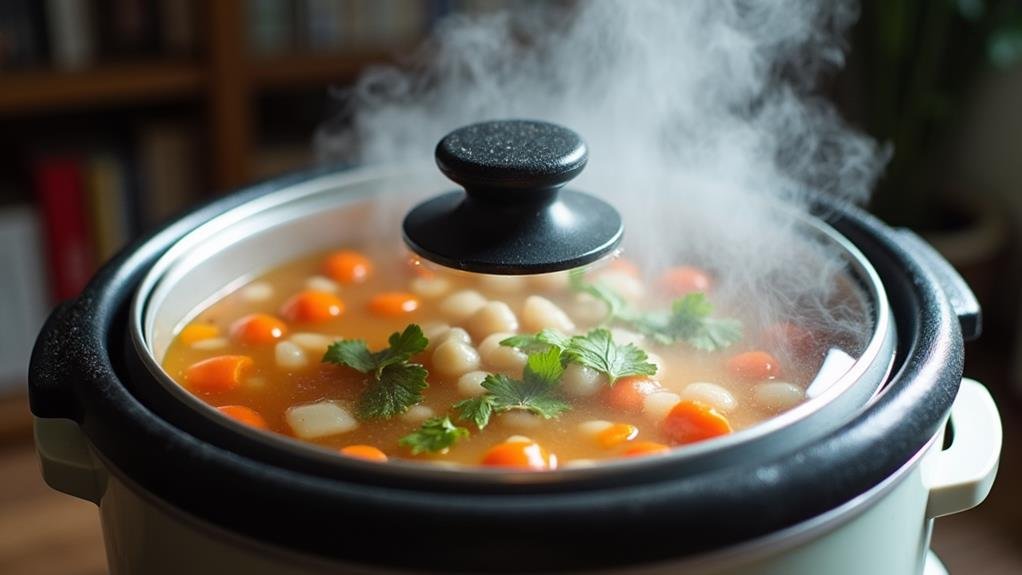
Let’s explore the steam setting on our rice cooker, which is ideal for preparing vegetables and other ingredients for our soups. We’ll find that this method effectively retains the nutrients, natural colors, and textures of our soup components. By using the steam setting, we’re ensuring our soups are packed with perfectly cooked, flavorful additions that enhance both taste and nutritional value.
Ideal for Vegetables
Vegetable lovers rejoice! The steam setting on our rice cookers is a game-changer for creating delicious and nutritious vegetable soups. We’ve discovered that this setting is ideal for quickly and efficiently cooking vegetables while retaining their essential nutrients and flavors. When we use the steam setting, our veggies maintain their vibrant colors and perfect textures, resulting in soups that are as visually appealing as they are tasty.
Let’s explore why the steam setting is perfect for our vegetable soups:
- Even cooking: The steam guarantees all vegetables are cooked uniformly, preventing mushy or overcooked bits.
- Nutrient retention: Steaming preserves more vitamins and minerals compared to boiling.
- Customization: We can easily add a variety of vegetables to create unique, personalized soup recipes.
We love how the steam setting allows us to effortlessly prepare healthy and delicious vegetable-based soups. It’s a versatile option that gives us the freedom to experiment with different ingredients and flavors. By using this setting, we’re not only saving time but also creating soups that are bursting with freshness and nutrition. Let’s embrace the steam setting and elevate our soup game together!
Retains Nutrients Effectively
The steam setting on our rice cookers is a nutritional powerhouse when it comes to preparing soups. We’re not just making meals; we’re creating nutrient-rich bowls of goodness that nourish our bodies and souls. By using the steam function, we’re preserving the natural vitamins and minerals in our ingredients, ensuring that every spoonful is packed with health benefits.
Let’s take a look at how the steam setting compares to other cooking methods:
| Cooking Method | Nutrient Retention | Flavor Preservation |
|---|---|---|
| Steaming | High | Excellent |
| Boiling | Low | Good |
| Brown Rice | Medium | Very Good |
As we can see, steaming is the clear winner when it comes to retaining nutrients and flavors. When we use the steam setting, we’re not just cooking; we’re nurturing our bodies with vibrant, flavorful soups that maintain their nutritional integrity. Unlike boiling, which can cause vitamins and minerals to leach into the cooking liquid, steaming gently cooks our ingredients while locking in their essential goodness. It’s like giving our soups a nutritional hug, ensuring that every bite is as healthy as it is delicious.
White Rice Mode
Let’s explore how the white rice mode on our rice cookers can be a game-changer for creating simple, flavorful soups. We’ll need to adjust our liquid ratios, typically using a 1:1.5 or 1:2 rice-to-water proportion, to achieve the perfect consistency for our soup base. It’s important to keep in mind cooking times, as we’ll want to add our vegetables, meats, and seasonings after the rice has cooked to maintain best textures and flavors in our finished soup.
Perfect for Simple Soups
For those looking for simplicity in soup-making, the white rice setting on your rice cooker is a game-changer. We’ve found that this setting is ideal for creating delicious soups with minimal effort. The consistent temperature of the white rice function ensures that our ingredients cook evenly and thoroughly, resulting in a perfectly balanced soup every time.
We love how this setting simplifies the soup-making process, making it perfect for beginners or anyone seeking a hassle-free option. It’s a time-saving solution that doesn’t compromise on flavor or quality. With the white rice setting, we can create savory soups without constantly monitoring the pot or adjusting temperatures.
Here are three reasons why we’re passionate about using the white rice function for soups:
- Consistency: It provides a reliable cooking temperature for optimal soup preparation.
- Convenience: We can easily add our ingredients and let the rice cooker do the work.
- Versatility: It’s perfect for a wide range of straightforward soup recipes, from classic chicken noodle to hearty vegetable.
Adjusting Liquid Ratios
When preparing soups using the white rice setting, we’ve discovered that adjusting liquid ratios is crucial for achieving the perfect consistency. In white rice mode, the absorption of liquid is higher, which can lead to thicker soups than desired. To address this, we’ve found that adding an extra cup of broth or water works wonders.
This simple adjustment prevents our soups from becoming too thick and guarantees they maintain a delightful texture. We’ve learned that the additional liquid serves multiple purposes. It accounts for the evaporation during cooking, keeping our soups from sticking to the bottom of the rice cooker. Plus, it enhances the flavors as all the ingredients simmer together, resulting in a more delicious and satisfying dish.
Cooking Time Considerations
Most rice cookers’ white rice mode offers an ideal setting for preparing delicious soups. We’ve found that this cook setting provides the perfect temperature and timing for simmering our favorite soup recipes. When we use the white rice mode, we can expect our soups to be ready in about 45 minutes to an hour, ensuring all ingredients are thoroughly cooked and flavors are well-blended.
The beauty of using the white rice mode for soups lies in its simplicity and effectiveness. Here’s why we love it:
- Consistent simmer: The preset temperature maintains a steady simmer, cooking ingredients evenly without burning.
- Versatility: It’s perfect for a variety of soups, from chicken and vegetable to hearty rice-based recipes.
- Balanced flavors: The cooking time allows for a harmonious blend of tastes and textures in our soups.
We’ve discovered that this cook setting takes the guesswork out of soup-making. By utilizing the white rice mode, we can confidently prepare soups that are both delicious and satisfying. It’s become our go-to method for creating comforting meals that bring us together around the table, sharing warmth and nourishment.
Brown Rice Option
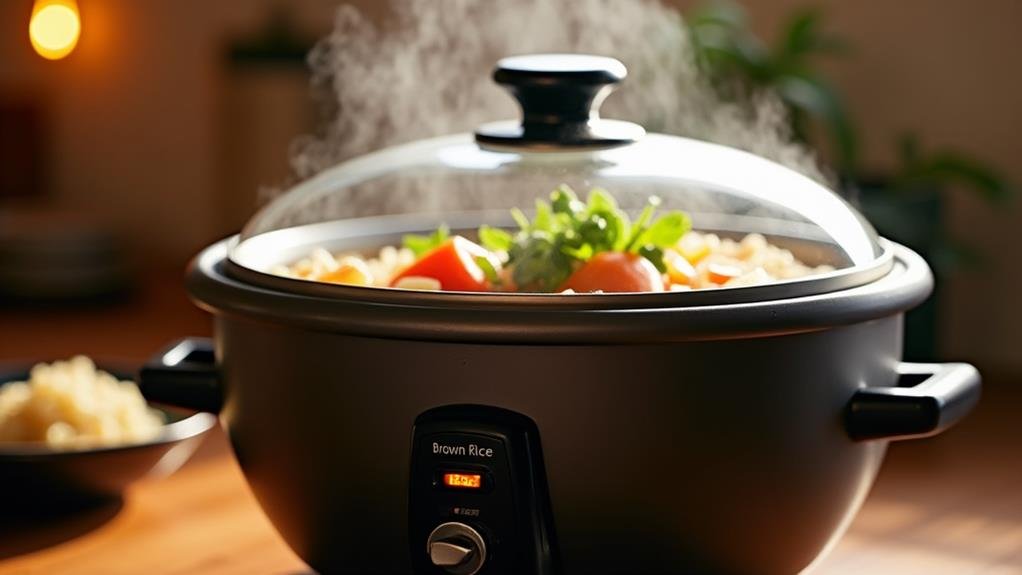
Rice cooker enthusiasts, rejoice! We’ve got a game-changing option for our soup-making adventures: the brown rice setting. This often-overlooked feature is our secret weapon for creating hearty, nutritious soups with a perfectly cooked brown rice base. The water-to-rice ratio for brown rice is essential, typically requiring more water than white rice, which is expertly managed by the rice cooker. By utilizing this cooking technique, we’re ensuring that our brown rice cooks to perfection, retaining its chewy texture and nutty flavor. These qualities are what make brown rice an excellent foundation for soups, adding depth and character to every spoonful.
But it’s not just about taste – we’re also boosting our soup’s nutritional value. Brown rice packs more nutrients and fiber than its white counterpart, making our soups even more wholesome. By mastering the brown rice setting, we’re crafting soups that aren’t just delicious but also nourishing. So, let’s embrace this option and elevate our soup game together. With the brown rice setting, we’re not just cooking; we’re creating experiences that warm both body and soul.
Multi-Grain Setting
Expanding our culinary horizons, we’re diving into the multi-grain setting on our trusty rice cooker. This versatile option allows us to explore a world beyond rice, perfectly cooking quinoa, millet, buckwheat, and more. We’ll discover that the multi-grain setting guarantees ideal texture and consistency for various grains, transforming our rice cooker into a multi-purpose kitchen powerhouse.
When using the multi-grain setting, we need to be mindful of adjusting water levels based on the specific grain we’re cooking. This attention to detail will help us achieve perfect results every time. Let’s embrace the convenience and possibilities this setting offers for creating healthy, nutritious grain-based soups with ease.
Here are three key benefits of using the multi-grain setting for our soups:
- Expanded variety in our meals
- Enhanced nutritional value through diverse grains
- Simplified cooking process for complex grain combinations
Quick Cook Feature
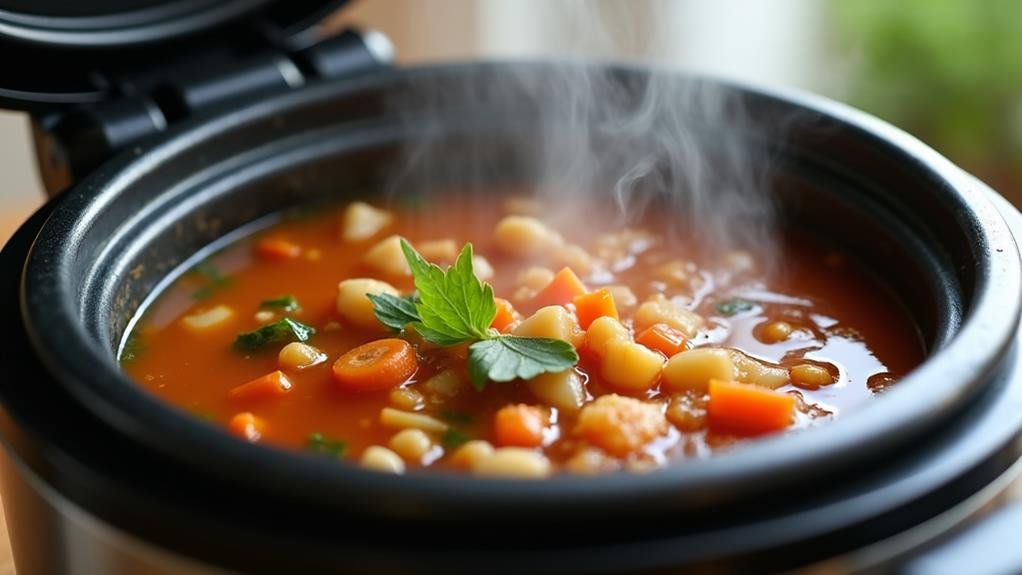
We’re excited to explore the Quick Cook feature, a game-changer for fast meal preparation. This energy-efficient cooking option allows us to whip up delicious soups in record time, making it perfect for busy weeknights or last-minute meals. By harnessing higher temperatures, the Quick Cook setting notably reduces cooking time without compromising on flavor, ensuring we can enjoy homemade soups with minimal effort.
Fast Meal Preparation
Imagine whipping up a delicious, steaming bowl of soup in mere minutes. With the quick cook feature on your rice cooker, this dream becomes a reality. We’ve discovered that this setting is a game-changer for busy weeknights when we’re craving a warm, comforting meal without the wait.
The quick cook option remarkably reduces cooking time, allowing us to enjoy hearty soups faster than ever before. But don’t let the speed fool you – these soups are packed with flavor and quality. We’re amazed at how well-developed the taste profiles are, even with the shortened cooking time.
Here’s why we love the quick cook feature for soups:
- It’s perfect for our hectic schedules, providing a convenient and efficient cooking solution.
- We can experiment with various soup recipes without sacrificing an entire evening.
- It allows us to enjoy homemade, nutritious meals more often, bringing us closer to our health goals.
Energy-Efficient Cooking Option
Efficiency meets flavor in the quick cook feature of modern rice cookers. We’ve all been there – craving a warm, comforting soup but short on time. That’s where this energy-efficient cooking option comes to our rescue. The quick cook setting is our secret weapon for whipping up delicious soups in record time, without compromising on taste or quality.
Let’s explore how this feature works its magic. By utilizing higher temperatures, the quick cook setting expedites the cooking process, saving us precious minutes and energy. It’s perfect for those hectic days when we need a satisfying meal but can’t afford to spend hours in the kitchen. We can simply toss our ingredients into the rice cooker, select the quick cook option, and let it work its wonders.
But remember, we’re not just saving time; we’re also being environmentally conscious. This energy-efficient cooking option allows us to create mouthwatering soups while minimizing our carbon footprint. It’s a win-win situation for both our taste buds and the planet. So, let’s embrace this innovative feature and enjoy quick, delicious soups without any guilt.
Keep Warm Mode
After the cooking process, your rice cooker’s Keep Warm mode becomes your soup’s closest ally. This convenient feature maintains your soup at the ideal serving temperature without overcooking it. We appreciate how it automatically kicks in once the cooking cycle ends, ensuring our delightful creation stays hot and ready for whenever we’re in the mood for a comforting bowl.
The Keep Warm mode is a game-changer for us soup enthusiasts. It allows us to:
- Serve piping hot soup at any time, even hours after cooking
- Maintain the perfect temperature without compromising flavor or texture
- Enjoy our soup at a consistent warmth, knowing it’ll stay cozy throughout our meal
We can’t emphasize enough how this setting revolutionizes our soup-making experience. It’s like having a personal sous chef keeping our soup at the ideal temperature. However, let’s remember not to leave our soup on Keep Warm for too long. While it’s a fantastic feature, extended use might cause our soup to dry out or lose its rich flavors. By using this mode wisely, we’ll always have a delicious, hot soup ready to warm our souls and bring us together around the table.
Sauté Function
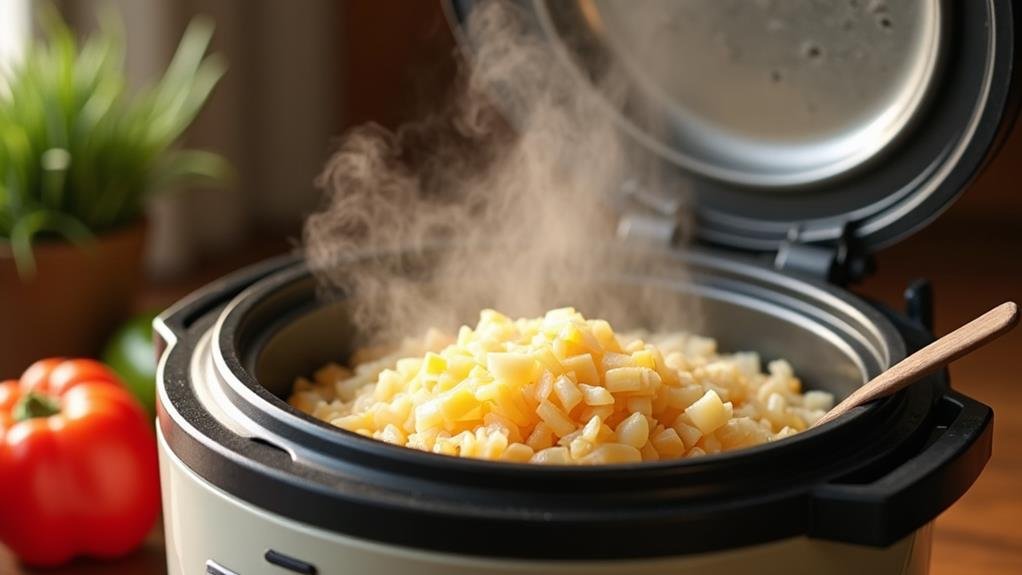
A culinary powerhouse lies hidden within our rice cooker’s sauté function. This versatile feature allows us to elevate our soup-making game, transforming simple ingredients into rich, complex flavors. We can brown meats and sauté vegetables right in the rice cooker, creating a foundation of taste that’ll make our soups sing.
Let’s reveal the full potential of our rice cooker’s sauté function. We’ll start by caramelizing onions and garlic, developing those deep, savory notes we all crave. Then, we’ll toast our favorite spices, releasing their aromatic oils and infusing our soup with layers of flavor. This method isn’t just about taste; it’s about efficiency too. We’re creating restaurant-quality soups without dirtying extra pans.
The beauty of the sauté function is its seamless integration with the soup setting. Once we’ve built our flavor base, we can switch to the soup mode and let our rice cooker work its magic. We’re not just making soup; we’re crafting a culinary experience that’ll bring us together, one steaming bowl at a time.
Custom Temperature Control
Occasionally, we stumble upon a feature that transforms our cooking experience, and custom temperature control in rice cookers is precisely that game-changer. When it comes to making soups, this feature allows us to fine-tune our cooking process with precision. We can adjust the temperature to prevent burning or overcooking delicate ingredients, ensuring that every spoonful of our soup is perfect.
Custom temperature control gives us the power to simmer our soups slowly, coaxing out rich flavors and creating depth in our broths. Whether we’re making a hearty vegetable soup or a delicate consommé, we can tailor the cooking process to suit our specific needs. This level of control is especially valuable when working with rice-based soups, as it allows us to achieve the ideal texture for both the rice and the other ingredients.
Here’s why custom temperature control is a must-have for soup lovers:
- Precision cooking for perfect results every time
- Ability to adapt to different soup types and ingredients
- Enhanced flavor development through controlled simmering
With this feature, we’re not just cooking soup; we’re crafting culinary masterpieces that bring us together around the table.
Conclusion
We’ve explored the incredible versatility of rice cookers for creating delicious soups. Did you know that using a rice cooker can reduce cooking time by up to 50% compared to traditional stovetop methods? That’s time we can spend savoring our creations! With settings like Porridge/Soup, Slow Cook, and Sauté, we’re equipped to craft restaurant-quality soups at home. Let’s embrace these multifunctional appliances and elevate our soup game to new heights. Happy cooking!


